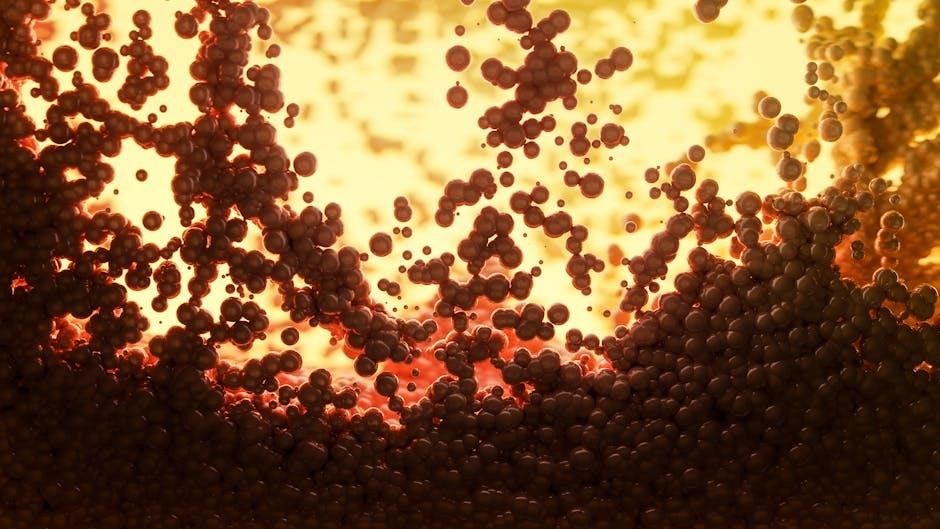
The PhET Energy Forms and Changes simulation‚ a valuable resource for science education‚ provides an interactive environment. It allows students to explore energy transformations. This engaging tool enhances understanding of key concepts.

Overview of PhET Interactive Simulations
PhET Interactive Simulations‚ developed by the University of Colorado Boulder‚ offer engaging and research-based simulations. These simulations cover various science and math topics. PhET aims to promote interactive learning through visual and intuitive interfaces.
What is PhET and its goals
PhET‚ or Physics Education Technology‚ is a project at the University of Colorado Boulder. PhET creates free online interactive simulations for science and mathematics education. The primary goal of PhET is to enhance the way students learn and understand complex concepts through engaging and visually rich simulations. These simulations are designed to be interactive and allow students to explore cause-and-effect relationships‚ fostering a deeper understanding. PhET also aims to make science and math education more accessible and enjoyable for students of all backgrounds‚ promoting a greater interest in STEM fields through innovative educational tools.
Accessibility and usability of PhET simulations
PhET simulations prioritize accessibility and usability‚ ensuring a broad range of students can effectively use them. The simulations are designed with intuitive interfaces and clear visual hierarchies‚ minimizing distractions and helping students focus on core concepts. PhET simulations are available online and can be accessed on various devices‚ including computers and tablets‚ without the need for specialized software. This widespread accessibility makes them suitable for diverse learning environments. Furthermore‚ PhET incorporates features that cater to different learning styles‚ offering customization options and interactive elements that promote active engagement and deeper understanding for all students.

Energy Forms and Changes Simulation: A Detailed Look
The Energy Forms and Changes simulation offers a comprehensive exploration of energy concepts. Students can manipulate variables. They can also observe energy transfer. The simulation promotes interactive learning.
Exploring different energy forms within the simulation
Within the PhET Energy Forms and Changes simulation‚ users can actively explore various energy forms‚ including thermal‚ mechanical‚ electrical‚ and light energy. The simulation allows for the visualization of how these different energy forms interact and transform within a closed system. Interactive components enable students to manipulate the system by applying heat or mechanical work‚ observing the resulting changes in energy distribution. Energy symbols provide a visual representation of energy movement. The simulation offers a hands-on approach to understanding the nature and behavior of different energy forms in diverse scenarios. This helps solidify comprehension;
Understanding energy transfer and transformations
The PhET Energy Forms and Changes simulation facilitates a deep understanding of energy transfer and transformations. Students observe how energy moves between different objects and forms‚ such as from potential to kinetic energy. The simulation visually demonstrates the principles of energy conservation‚ highlighting that energy is neither created nor destroyed‚ but rather changes form. Users can manipulate various scenarios‚ like heating water or using solar panels‚ to see how energy is converted. By interacting with these dynamic systems‚ students can develop an intuitive grasp of energy transformations and their real-world applications. This interactive learning supports a more robust understanding.
Manipulating variables and observing outcomes
With the Energy Forms and Changes simulation‚ students can actively manipulate variables and directly observe the resulting outcomes. This hands-on approach allows for deeper exploration of energy concepts. Users can adjust parameters such as the amount of heat applied to a system or the intensity of sunlight on a solar panel. They can then observe how these changes affect energy transformations and transfers within the simulation. By experimenting with different variables‚ students develop a stronger understanding of cause-and-effect relationships in energy systems. This interactive process fosters critical thinking and problem-solving skills‚ enhancing their overall learning experience.

Using the Simulation for Educational Purposes
The PhET Energy Forms and Changes simulation is highly adaptable for educational integration. Its intuitive design makes it suitable for diverse teaching strategies. It effectively supplements lesson plans.
Integrating the simulation into lesson plans
Integrating the PhET Energy Forms and Changes simulation into lesson plans can significantly enhance students’ learning experience. This tool is useful for illustrating abstract concepts related to energy transformation. Teachers can utilize the simulation to demonstrate energy transfer processes and conservation principles in real-time. By manipulating variables within the simulation‚ students can actively explore the effects of different factors on energy systems. For instance‚ investigations into the different energy input and output options in the simulation and observing the resultant changes can give students a hands on and visual experience.
Suitable grade levels and subjects
The PhET Energy Forms and Changes simulation is versatile and suitable for a range of grade levels and subjects. Primarily designed for middle school and high school students‚ it effectively supports physics and chemistry curricula. The simulation is particularly useful when teaching topics such as energy conservation‚ energy transfer‚ and different forms of energy. It can also be integrated into general science courses to introduce fundamental energy concepts. Moreover‚ the interactive nature of the simulation makes it accessible and engaging for diverse learners‚ enhancing their comprehension of complex scientific ideas.

Answer Key and Worksheet Integration
Answer keys are essential tools for educators using the PhET simulation. They offer solutions to accompany worksheets. Worksheets are helping students reinforce their understanding and engage actively with the material presented in the simulation.
Purpose of the answer key
The primary purpose of an answer key for the PhET Energy Forms and Changes simulation is to provide educators with a reliable tool for assessing student comprehension. It ensures accurate evaluation of completed worksheets associated with the simulation. Answer keys offer correct responses‚ streamlining the grading process and saving valuable time for teachers. Additionally‚ they serve as a reference‚ helping educators identify areas where students may struggle. This enables targeted intervention and personalized support‚ ultimately enhancing the learning experience. Furthermore‚ answer keys promote consistency in grading across different students and classes‚ ensuring fair evaluation.
How to effectively use worksheets with the simulation
To maximize the educational impact of worksheets with the PhET Energy Forms and Changes simulation‚ begin by aligning worksheet questions with specific simulation features. Encourage students to actively explore the simulation before attempting the worksheet‚ fostering hands-on learning. Integrate questions that require data collection and analysis directly from the simulation. Promote critical thinking by including open-ended questions that prompt students to explain their observations. Utilize the worksheet as a guide for exploration‚ encouraging students to manipulate variables and record outcomes. Review student responses‚ providing feedback on both accuracy and reasoning. This iterative process strengthens comprehension and reinforces key concepts related to energy.

Activities and Experiments with the Simulation
Engage students with hands-on activities using the PhET simulation. Design experiments that explore energy transfer. Encourage inquiry-based learning through manipulation of variables. Observe outcomes to solidify understanding.
Examples of hands-on activities
One activity involves using the “Energy Systems” tab to investigate energy transformations. Students can connect a water faucet‚ a generator‚ and a lightbulb. By manipulating the water flow‚ they observe how potential energy converts into kinetic‚ then electrical‚ and finally light energy. Another activity explores heating different materials like water‚ oil‚ iron‚ and brick. Students can add the same amount of heat energy to each and observe temperature changes. This helps them understand specific heat capacity. Additionally‚ students can investigate solar panels and their efficiency. They can observe how solar energy transforms into electrical energy‚ powering different devices. These hands-on activities promote active learning.
Inquiry-based learning using the simulation
The PhET Energy Forms and Changes simulation facilitates inquiry-based learning. Students formulate their own questions about energy transformations. They design experiments within the simulation to test their hypotheses. For instance‚ students might investigate how the type of material affects heat transfer. By manipulating variables like material type and heat input‚ they collect data. They then analyze the data to draw conclusions about thermal conductivity. The simulation empowers students to explore‚ discover‚ and construct their own understanding. This hands-on approach fosters critical thinking and problem-solving skills. It also encourages a deeper engagement with the concepts of energy and its various forms.

Troubleshooting and Common Issues
Addressing issues‚ ensure the latest browser version is used for optimal simulation performance. Clear browser cache and disable extensions that may interfere. Review PhET’s help resources for specific troubleshooting steps and FAQs.
Addressing technical difficulties
When encountering technical difficulties with the PhET Energy Forms and Changes simulation‚ several troubleshooting steps can be taken. First‚ ensure that your web browser is up-to-date‚ as older versions may lack the necessary compatibility for the simulation to run smoothly. Clearing the browser’s cache and cookies can also resolve issues caused by corrupted or outdated data. If problems persist‚ try disabling browser extensions‚ as some may conflict with the simulation’s functionality. Additionally‚ verify that JavaScript is enabled in your browser settings‚ as PhET simulations rely on it. Check your internet connection.
Clarifying misconceptions about energy concepts
The PhET Energy Forms and Changes simulation is a powerful tool for addressing common misconceptions about energy. Many students struggle with understanding the conservation of energy‚ often believing that energy is lost or created during transformations. The simulation helps by visually demonstrating how energy changes form but is never truly lost. Another common misconception is that heat and temperature are the same; the simulation clarifies the difference by showing how heat is the transfer of thermal energy. Students will grasp that energy is a fundamental property‚ and they can manipulate it.

Assessment and Evaluation
Assessment with the PhET simulation involves observing student interactions and analyzing their responses to targeted questions. Evaluation can include quizzes. These quizzes will test knowledge of energy transformations. Analysis of conceptual understanding can also be part of the evaluation.
Methods for assessing student understanding
Several methods can effectively gauge student understanding of energy concepts within the PhET simulation. These include observing student interactions during simulation use‚ noting how they manipulate variables and interpret outcomes. Analyzing student responses to targeted questions posed during or after the simulation is crucial.
Furthermore‚ incorporating short quizzes or worksheets that require students to apply their knowledge gained from the simulation helps solidify understanding. Assessing their ability to predict energy transformations in different scenarios presented by the simulation offers valuable insights. Lastly‚ encourage students to explain their reasoning and justify their conclusions based on simulation observations‚ revealing their comprehension.
Using the simulation for formative assessment
The PhET Energy Forms and Changes simulation provides an excellent platform for formative assessment. Observe student interactions as they explore different energy systems; Note their ability to predict outcomes. Ask probing questions during the simulation to gauge real-time comprehension.
Utilize built-in tools or create simple worksheets to check understanding of key concepts. Analyze student explanations of energy transformations. This reveals misconceptions early on. Encourage peer discussion and collaborative problem-solving within the simulation. This fosters a deeper understanding. Collect and review student work to identify areas needing further instruction. This informs future lesson planning and differentiation. The simulation’s interactive nature promotes continuous assessment and learning.

Benefits of Using PhET Simulations
PhET simulations enhance engagement through interactive visualization. They improve comprehension of abstract scientific concepts. The simulations offer a hands-on learning experience. This leads to a deeper understanding and greater student interest.
Enhanced engagement and visualization
PhET simulations significantly enhance student engagement by offering interactive and visually appealing learning experiences. The simulations use dynamic animations and real-time feedback. This captures students’ attention and motivates them to explore scientific concepts actively. Furthermore‚ the visual nature of PhET simulations makes abstract ideas more concrete and understandable. Students can directly observe and manipulate variables to see the effects. This hands-on approach fosters a deeper‚ more intuitive understanding of complex phenomena. The ability to visualize energy transformations and other scientific processes promotes a more engaging and effective learning environment. This ultimately leads to improved student outcomes and a greater interest in science.
Improved understanding of abstract concepts
PhET simulations excel at clarifying abstract scientific concepts. These simulations offer interactive‚ visual representations that make complex ideas more accessible. By allowing students to manipulate variables and observe outcomes‚ PhET simulations bridge the gap between theory and practice. This hands-on experience fosters a deeper‚ more intuitive understanding. Students can visualize processes that are typically invisible. This includes energy transfer and molecular interactions. The simulations provide immediate feedback‚ reinforcing correct understanding and addressing misconceptions in real-time. Ultimately‚ PhET simulations empower students to grasp challenging concepts more effectively. This leads to improved problem-solving skills and a stronger foundation in scientific principles.
